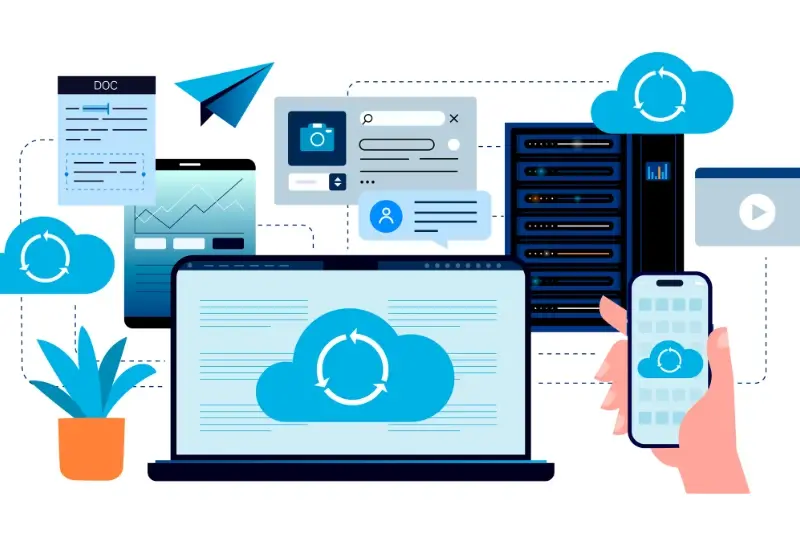Choosing Your Cloud Platform: AWS vs Google Cloud vs Azure For Mobile Apps
Last month I was chatting with a client who'd just launched their fitness app. They were buzzing about their user numbers but stressed about one thing—their backend was creaking under the pressure. They'd started with a basic server setup and now they were scrambling to keep their app running smoothly. Sound familiar? This happens more often than you'd think, and it's exactly why choosing the right cloud platform from the start matters so much.
When we're building mobile apps, we often get caught up in the fun stuff—the design, the features, how smooth the animations look. But behind every great app is a solid cloud platform doing the heavy lifting. It's storing your user data, handling push notifications, managing user authentication, and scaling up when your app suddenly goes viral.
The cloud platform you choose today will either support your app's growth or become the bottleneck that holds it back
The three big players in this space are AWS, Google Cloud, and Microsoft Azure. Each has its strengths and quirks, and picking the wrong one can cost you time, money, and a lot of headaches down the road. Over the years, I've worked with all three platforms across different projects, and I've learned that there's no one-size-fits-all answer. The best choice depends on your specific needs, budget, and technical requirements.
What Are Cloud Platforms And Why Do They Matter For Mobile Apps
Cloud platforms are basically massive computer systems that live on the internet instead of sitting on your desk. Think of them as incredibly powerful computers that you can rent space on—you don't need to buy the hardware, maintain it, or worry about it breaking down. Companies like Amazon, Google, and Microsoft run these huge data centres packed with servers that your mobile app can use.
Now, you might be wondering why your mobile app needs cloud platforms at all. Well, modern mobile apps aren't just pretty interfaces that work offline anymore. They need to store user data, send push notifications, handle user authentication, and often sync information between different devices. Your app might work perfectly on your phone, but what happens when a million people download it? That's where cloud platforms come in.
What Cloud Platforms Actually Do For Your App
Cloud platforms handle all the behind-the-scenes work that makes your app function properly. They store your app's data, manage user accounts, send those notifications that bring users back to your app, and scale up automatically when lots of people are using your app at once. Without cloud platforms, you'd need to buy and maintain your own servers—which gets expensive fast and requires serious technical expertise.
- Store and manage user data securely
- Handle user authentication and accounts
- Send push notifications to users
- Scale automatically when app usage increases
- Provide backup and disaster recovery
- Offer analytics and performance monitoring
AWS For Mobile Apps — The Market Leader's Strengths And Weaknesses
AWS dominates the cloud market for good reason—it's been around the longest and has the most comprehensive service offerings. When I'm working with clients who need serious computing power or have complex backend requirements, AWS often comes up as the natural choice. Their mobile services include AWS Amplify, which handles authentication, APIs, and hosting, plus AWS AppSync for real-time data synchronisation.
The platform's biggest strength is its maturity and reliability. You get access to hundreds of services that can handle everything from simple file storage to advanced machine learning capabilities. The global infrastructure means your app can perform well anywhere in the world, which is brilliant for apps targeting international markets.
Where AWS Falls Short
But let's be honest—AWS can be overwhelming for smaller projects. The learning curve is steep, and the pricing structure can be confusing. You might find yourself paying for services you don't actually need, especially when you're just starting out.
Start with AWS Amplify's free tier to test the waters before committing to larger services—it's perfect for prototyping mobile apps without breaking the bank.
| Strengths | Weaknesses |
|---|---|
| Comprehensive service range | Complex pricing structure |
| Excellent global infrastructure | Steep learning curve |
| Strong enterprise support | Can be overkill for simple apps |
Google Cloud For Mobile Apps — Firebase Integration And Developer Tools
Google Cloud's biggest strength for mobile development isn't just the cloud platform itself—it's Firebase. This backend-as-a-service platform has become the go-to choice for many mobile developers, and for good reason. Firebase handles all the server-side stuff that would normally take weeks to build: user authentication, real-time databases, push notifications, and analytics all work straight out of the box.
What makes Firebase special is how seamlessly it integrates with both Android and iOS apps. You can literally have a working backend running within minutes of setup. The real-time database syncs data across devices instantly, which is perfect for chat apps or collaborative tools. Authentication supports everything from email login to social media accounts without writing complex security code.
Key Firebase Features for Mobile Development
- Real-time database with offline sync capabilities
- Authentication system supporting multiple login methods
- Cloud messaging for push notifications
- Analytics and crash reporting built-in
- Cloud storage for images and files
- Machine learning APIs for advanced features
Google Cloud also provides excellent developer tools including Cloud Functions for serverless computing and BigQuery for data analysis. The platform's machine learning capabilities are particularly strong—you can add features like image recognition or text translation without being an AI expert. The free tier is generous too, making it perfect for startups testing their ideas.
Microsoft Azure For Mobile Apps — Enterprise Focus And Hybrid Solutions
Microsoft Azure takes a different approach compared to AWS and Google Cloud—it's built with big businesses in mind from the ground up. I've worked with plenty of enterprise clients over the years, and Azure consistently wins when they need to connect their mobile apps to existing Microsoft systems like Office 365, Active Directory, or their on-premises servers.
The real strength of Azure lies in its hybrid capabilities. Many large companies can't move everything to the cloud straight away (or don't want to), so Azure lets them keep some systems on their own servers whilst connecting seamlessly to cloud services. This makes it brilliant for enterprise mobile apps that need to access company databases or internal tools.
Azure Mobile App Service
Azure Mobile App Service handles the backend work quite well—authentication, data storage, and push notifications are all sorted. The Visual Studio integration is particularly smooth if your development team already uses Microsoft tools. Authentication is especially strong since it plugs straight into Active Directory, which most enterprises already use.
Azure's enterprise integration capabilities are unmatched when you're already invested in the Microsoft ecosystem
The downside? Azure can feel a bit clunky if you're not already using Microsoft products. The learning curve is steeper than Firebase, and the pricing can get complicated quickly. For startups or smaller apps, it might be overkill—but for enterprise mobile apps, it's often the most logical choice.
Comparing Costs — Which Platform Offers The Best Value For Mobile Development
Right, let's talk money—because that's what everyone really wants to know, isn't it? After years of working with clients on mobile projects, I can tell you that cost conversations come up in every single meeting. The tricky bit is that cloud platform pricing isn't straightforward; it's like trying to compare mobile phone contracts where everyone structures their deals differently.
Breaking Down The Numbers
AWS tends to be the most expensive upfront, but they've got the most mature pricing options and discounts for long-term commitments. Google Cloud often comes out cheaper for compute-heavy apps—they're quite aggressive with their pricing to win market share. Azure sits somewhere in the middle, but if you're already using Microsoft products, their bundled deals can make them the cheapest option overall.
The Hidden Costs Nobody Mentions
Here's what catches people out: data transfer costs, storage fees, and those sneaky little charges for API calls that add up fast. Firebase might look free until your app takes off and suddenly you're paying hundreds for database reads. AWS charges for everything—even monitoring your own app costs money! My advice? Always budget 30% more than the calculator suggests because there are always surprise costs that pop up once you're live.
Performance And Scalability — How Each Platform Handles Mobile App Traffic
When your mobile app suddenly goes viral or gets featured in the App Store, your cloud platform needs to handle the rush without breaking a sweat. I've seen apps crash spectacularly because they weren't prepared for success—and trust me, it's not a good look when users can't access your app during peak moments.
AWS leads the pack with its auto-scaling capabilities and global network of data centres. Their Elastic Load Balancing spreads traffic across multiple servers automatically, whilst CloudFront delivers content from the nearest location to your users. Google Cloud matches this with impressive speed, particularly for apps using Firebase—their real-time database can handle millions of concurrent connections without hiccups.
Real-World Performance Differences
Azure shines when it comes to hybrid solutions and enterprise-grade performance. Their content delivery network spans more countries than most competitors, which means faster loading times for users worldwide. What's interesting is that all three platforms offer similar baseline performance—the real difference comes down to how well they integrate with your specific tech stack.
Set up monitoring and alerts from day one. Performance issues are much easier to fix when you catch them early, and all three platforms offer excellent monitoring tools that can save you headaches later.
The truth is, any of these platforms can handle massive scale when configured properly. The key is understanding your app's specific needs and choosing the platform that makes scaling feel effortless rather than stressful. Whether you're building mobile apps for small businesses or enhancing customer engagement, the right platform choice can make all the difference.
Conclusion
After building mobile apps on all three platforms over the years, I can tell you that there's no single "best" choice—it really depends on what you're building and who you're building it for. AWS gives you the most comprehensive toolset and has the biggest community, but it can feel overwhelming if you're just starting out. Google Cloud shines when you want Firebase integration and those brilliant developer tools, making it perfect for rapid prototyping and apps that need real-time features. Azure? Well, if you're working with enterprise clients or need hybrid solutions, it's hard to beat.
The truth is, all three platforms will handle your mobile app's needs perfectly well. I've seen successful apps running on each one. What matters more is picking the platform that matches your team's expertise, your budget constraints, and your specific requirements. Don't get caught up in the technical specifications—focus on which platform will let you build and launch your app most efficiently.
My advice? Start with the platform that feels most comfortable to your development team. You can always migrate later if needed, though honestly, most apps never need to. The real magic happens when you stop worrying about the infrastructure and start focusing on creating something people actually want to use.
Share this
Subscribe To Our Blog
You May Also Like
These Related Stories

Edge Computing vs Cloud Computing: Which Is Right for Your App?

Cloud Infrastructure for Mobile Apps: A Beginner's Reality Check





